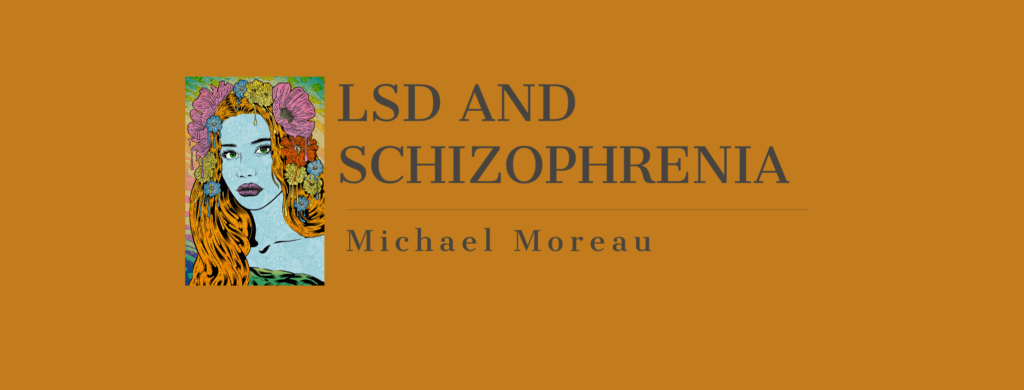From the get-go, here’s my thesis (or the “tl;dr” if you were born after Lady Gaga wore a meat dress to the MTV video music awards): lysergic acid diethylamide (LSD) is as effective or better than existing pharmacological interventions for schizophrenia1. As it turns out, I’m not the first person to advance this thesis2, and it appears that Canada was even a hotspot for this hypothesis in the early 1950s3. In fact, a study conducted in 1958 found remarkable results when small doses of LSD were used in a group therapy setting to treat schizophrenic patients4. Convinced yet? If not, read on!
What is schizophrenia?
Psychiatry’s current understanding of schizophrenia, like most other mental illnesses, essentially boils down to two things:
- A list of symptoms that, when taken together, represent a diagnosis of schizophrenia (see DSM-V6); and
- A list of medications that might treat some of these symptoms.
There is another perspective, however, that may provide different answers: an Indigenous perspective. In this Ted Talk7, Phil Borges, an American filmmaker and photographer, gives an overview of how various Indigenous cultures understand and respond to psychosis. Perhaps most interestingly, he explains how a medium to channel the Nechung Oracle of Tibet was selected. When a man was young, he began to fall ill, heard ‘voices’ and was certain he would die, that is, until a monk declared he had a spiritual gift. After studying with this monk for a year, the man went on to become the State Oracle of Tibet, expressing the voices to provide prophetic wisdom and counsel to the Dalai Lama. In this understanding, psychosis isn’t pathologized but is instead celebrated as the beginning of a spiritual awakening.
What is LSD?
On a molecular level, LSD is a tryptamine and a phenethylamine. For the uninitiated, this means that LSD is a complex type of neurotransmitter, or, put even more simply, a drug. Neurotransmitters are the molecules that make up the symphony of our brains, but despite their small size, they can pack quite the punch! A dose of LSD, for example, ranges anywhere from 10 to 1000 micrograms (unit: μg); in other words, while a microgram is one millionth (i.e. 10-6) of a gram, the more standard milligram (unit: mg) weighs a hefty thousandth (i.e. 10-3) in comparison.
What about LSD and schizophrenia?
LSD, along with a host of other hallucinogenic drugs, targets the brain’s 5-HT2A receptor, belonging to the serotonin receptor family; incidentally, this receptor is also partly responsible for mediating the action of certain atypical antipsychotic drugs8 used in the treatment of schizophrenia, including clozapine (e.g. Clozaril, Leponex, Versacloz). In fact, when LSD was first released to consumers under the brand name ‘Delysid’ in 1947, Sandoz Laboratories, the drug’s manufacturer, marketed it as a cure for schizophrenia and even alcoholism9. The company’s medical literature on LSD also, interestingly enough, even suggested it could help “gain an understanding of the subjective experiences of the schizophrenic,” and, as a matter of fact, modern research echoes this statement10.
LSD may also be useful in treating sleep disturbances in schizophrenic populations, which is a common affliction for those on antipsychotic medication11. This is especially damaging as sleep issues often unfortunately compound the severity of illness, resulting in a poor prognosis and poor quality of life12. Some researchers think that differences in genetic structure are responsible for dysregulating histamine metabolism in the schizophrenic population, which appears to be correlated with clozapine-induced sedation and daytime somnolence in patients taking that medication13. LSD, however, can be stimulating and has a strong affinity for the H1 receptor (i.e. its antihistamine properties) which could ostensibly promote wakefulness and reduce the negative impact wrought by sleep disorders.
Tangentially, it’s worth noting that the co-founder of Alcoholics Anonymous believed that LSD could help alcoholics understand their alcohol-induced hallucinations14, which coincidentally share the trademark features of schizophrenic hallucinations: “auditory and visual hallucinations, most commonly accusatory or threatening voices.”.
Closing Thoughts
Conventional knowledge holds that it would be irresponsible to suggest that someone in psychosis consume LSD without medical supervision – especially with dozens of anecdotes concerning people who took LSD and experienced psychotic symptoms. Logic would seem to pretty firmly suggest that a hallucinogen is the last thing you’d want to give to someone who’s already hallucinating! While this is grounded in solid intuition, intuition should not weigh more than evidence in this case, especially when so many of our fellow human beings would benefit from higher quality, more informed, evidence-based policy choices. As a result, it is essential that clinical research on alternative antipsychotic medication be conducted to provide this knowledge.

